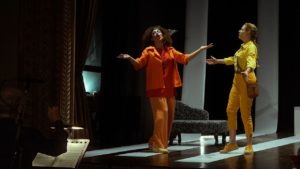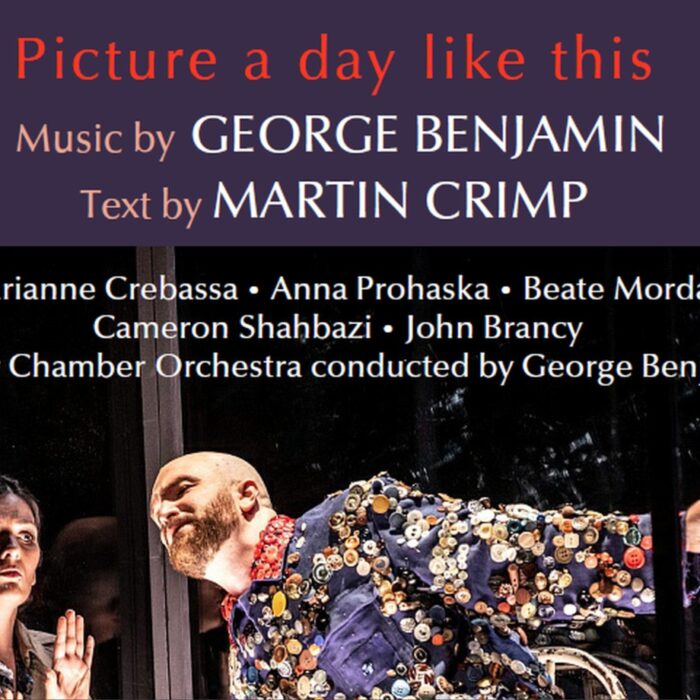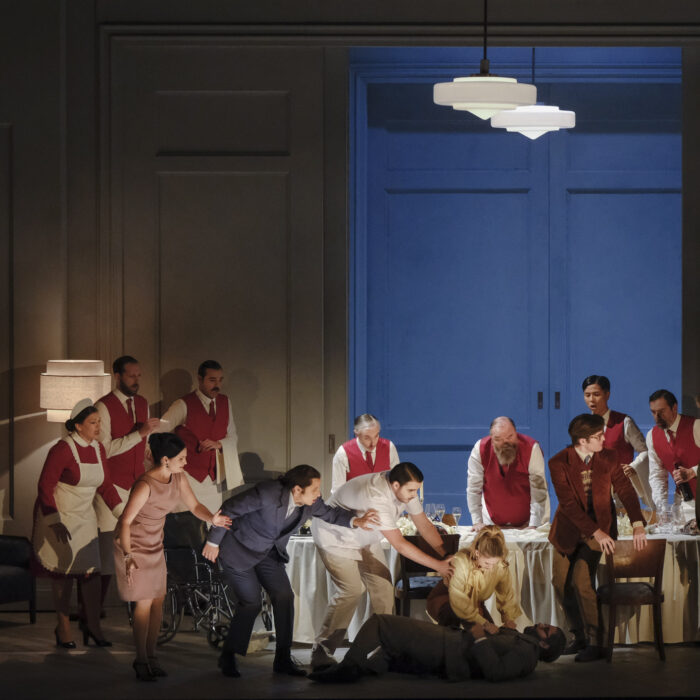
Palazzo Altemps Rome 2021 Review: Moro Per Amore
Young Talent Bring Stradella’s Final Opera To The Stage In A Renaissance Palazzo
By Alan Neilson(Photo: Stradella Y-Project)
Situated about a two minute walk from Rome’s Piazza Navona is the Palazzo Altemps, a building originally designed by Melozzo da Forlì for Girolamo Riario, Lord of Imola in the fifteenth century. Over the years it was enlarged and developed into what is now a magnificent Renaissance residence.
The Riario family’s tenure of the building was a relatively short one, and ownership changed hands on a number of occasions, with cardinals and foreign ambassadors included among its past owners.
Today, it is one of the sites of the National Roman Museum, housing a spectacular collection of sculptures from the ancient world. Although bypassed by many tourists, it really is a remarkable collection, and a must-see for anyone with even a passing interest in sculpture or antiquity. One piece which caught the eye on a recent visit was the Juno Ludovisi, a giant marble head of the goddess Juno from the first century AD. The novelist Henry James included it in his 1873 impressions of the Villa Ludovisi where it was housed at the time, writing “where the colossal mask of the famous Juno looks out with blank eyes.”
Also within the Palazzo Altemps is a private chapel from the 17th century, and a small theatre constructed in the sixteenth century, where the young Mozart once performed. Although the theatre fell into disuse, it was restored to its original design in the 1980s, and has now just played host to two performances of Alessandro Stradella’s final opera “Moro per Amore” from 1681.
The opera on the surface is the usual tale of jealousy, love and rejection, of disguises and misunderstandings in which all eventually ends happily. However, the libretto, written by the francophile Flavio Orsini, Duke of Bracciano, contains within it a political and social portrait of late 17th century Rome, along within its intendant social tensions, set against the background of the power games involving France, Spain and the Church.
Clear Direction
The director Fabiano Pietrosanti, supported by stage and costume designer Nicole Figini, updated the setting to the present day. The set was simple, consisting of a chaise longe and two chairs against a black and white background.
However, it served its purpose well, and along with the colourful costume designs, it ensured that the staging was functional and pleasing on the eye. Pietrosanti was also successful in clearly defining and bringing the characters to life with the use of gestures, facial expressions and his intelligent management of interactions.
The performances were given by the Stradella Young Project, an organisation founded in 2011 to promote the music of baroque composers from the Lazio region of Italy, in particular the music of Stradella by employing young singers and instrumentalists. Although the cast was certainly young, a quick look through their biographies made it clear that they all possessed stage experience, albeit to varying degrees, some of whom already have a substantial performance repertoire on their CVs.
The most demanding role is that of Eurinda, the Queen of Sicily, who not only has many arias to sing, but is also responsible for carrying a major part of the drama. A weak performance in the role would kill the production. The role fell to soprano Joanna Radziszewska who was more than up to the task, producing a most impressive performance, in which she not only successfully captured the passions of the character, but also injected some humour into the role, as she arrives on stage exhausted after a hard day’s shopping.
She possesses a strong, bright, versatile voice with a well-grounded technique, which she employed intelligently in bringing depth and nuance to her interpretation, and successfully engaged with what is a diverse range of arias. There was always a lot of movement in the voice, as she highlighted the vocal line with emotional accents and dynamic inflections, and was comfortable in spinning out long sweet lines, accented coloraturas or enveloping the voice with emotion.
The aria “Sepellitevi nel core ciechi affetti che nascete” was well-delivered and displayed her neat phrasing, notwithstanding the occasional squally emission, while “Con lo strale che fatale” allowed her to show off her coloratura and musical expressivity. However, the aria which really caught the attention was “Furie terribili” in which she gives voice to her anxieties and frustrations, and displayed her ability to identify with the character, in what was a highly emotional rendition. Her recitatives were also delivered with equal success.
The King of Cypress Floridoro, who for most of the opera is disguised as the servant Feraspe, was played by countertenor Danilo Pastore. Having reviewed Pastore’s past performances on a couple of occasion it was opportunity to see how he is developing. Clearly, he is a singer who is happy to be singing the baroque repertoire, in which he embraces the ideals of elegance and refinement when approaching a character, both in his singing and acting. There is rarely any histrionics on display, emotions tend to be idealized, and it is certainly an approach that can work.
However, it did not really connect fully with the approach of Pietrosanti, who encouraged a more emotional presentation, so that Pastore tended to appear aloof and cold, not fully emotionally engaged. There is also a reluctance for him to take risks, everything tends to be correct and precise, perhaps too much so. Nevertheless, he presented his arias neatly, if a little underpowered, but without ever moving out of his comfort zone.
His aria “la fortuna é non troppo avara” showed off his voice in the best light, with a pleasing lyrical presentation, in which he allowed the darker colours of his baritone to seep into the bright tones of his countertenor. It was performance which in a different production might have been more successful.
Soprano Ines Vinkelau was cast in the role of Lucinda, First Lady of the Court, whose impulsive behaviour is responsible for causing big problems. She produced a performance which had much to admire, in which she displayed sensitivity to both the musical and the textural meanings.
Recitatives were delivered with passion and energy, although occasionally over-stressed. Arias were pleasingly rendered, although there was a notable hardening of the voice when she pushed into the top end of her upper register. The aria “T’intendo, si t’intendo” was the standout, in which her phrasing, vocal control and emotional sensitivity impressed. “Fugga il pianto, o miei pensieri” was also given an affective reading, in which she successfully and imaginatively embellished the vocal line.
Mezzo-soprano Eleonora Filipponi was wonderful in the role of the nurse Lindora. She possesses a very distinctive voice with an exceptionally wide range of colours which she used to good effect in producing a well-defined presentation, full of energy and detail. Arias were delivered with a careful eye on their dramatic impact, and successfully used to develop her character. They were also crafted to bring out the nuances of the text through the use of well placed accents and sharp shifts in tonal colouring, which produced an interesting chiaroscuro effect.
Moreover, she has a very strong stage presence which she used successfully to produce a strong and sympathetic portrait of her character. Her recitatives were lively and expressive and her interactions with the other characters were bold and animated.
Tenor Carlos Arturo Gomez Palacio, who was probably the most inexperienced of the cast, was parted as Filandro, the Ambassador from Naples. He produced an interesting performance, in which his inexperience, although clearly evident, was balanced by the pleasing timbre of his voice and his ability to spin out sweet lyrical lines. He was, however, too conservative in his approach, and needs to attack his roles with a bit more energy and passion to fully convince.
Soprano Alicja Ciesielczuk produced an ambitious and enthusiastic, albeit inconsistent performance in the role of Floridoro’s servant, Fiorino. Her voice displayed agility and strength, but she often compromised vocal beauty by focusing on vocal characterisation and emotional affects, to the extent that at times she lost the right balance.
Rodrigo, the Queen’s faithful advisor was played by bass Masashi Tomosugi. Although not a large role, he made a very strong impression. His voice has a warm dark texture with a clean sound, which he projects powerfully and with a confident air. Recitatives were expressive, with full attention given to their meaning, and his aria displayed beauty and technical skill in equal measure. Overall, it was a performance of considerable maturity.
A Young Talented Orchestra
The theatre is only small and its stage is not raised much above the floor of the auditorium, and there is no specific space for the orchestra, all of which compromised the balance between singers and orchestra. Positioning the orchestra directly in front of the stage was not really an option, so it was divided into two parts and seated in front, but to the left and right of the stage with the musical director Andrea De Carlo in the centre. Visually it worked. Musically it worked for the orchestra, which consisted of ten players. However, the sound of the singers had to pass through the sound of the orchestra, and it meant that some of the singers struggled to be heard with sufficient clarity.
De Carlo elicited an excellent performance from the young orchestra, producing an integrated, sharp, yet sensitive sound, which successfully brought Sradella’s melodies alive. Many of the arias are rhythmically strong, and the orchestra showed real flair in the manner in which it attacked them, as it overflowed with energy. It was equally successful in crafting the more sedate arias which were rendered with a greater degree of reflection. Despite the problems of balance De Carlo was supportive of the singers
Overall, this was an interesting and successful presentation from the Stradella Young Project, not least because it is not often one has the opportunity to attend a performance of one of Stradella’s operas, and the fact that it was so well presented by such a young cast was a real bonus.



